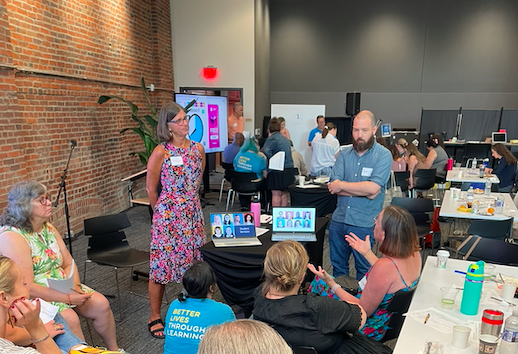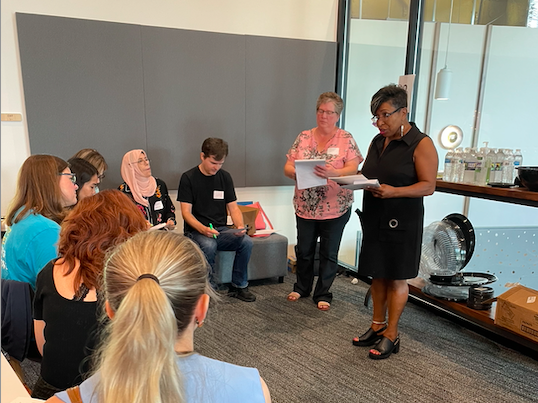When the entire staff at Literacy Pittsburgh came together for their semi-annual all staff retreat, the agenda was no surprise to anyone. CEO Carey Harris and her leadership team had been preparing for it ever since the last staff retreat wrapped up six months before.
For anyone attending, it was easy to see the through-line. Instead of feeling like a single moment in time, the retreat felt like part of an ongoing conversation amongst the team: here’s where we were, here’s where we are today, and here’s where we’re going. It was simultaneously a backstop for getting big things done, an opportunity to learn together about where the organization is today, and a chance to look six months into the future to where they want to be when they come together at the next one. The day even included time to start making progress on some of the big milestones they’re aiming to complete in the six months ahead.
The high-level goals of this summer staff retreat were the same as those that guided the winter retreat: connect, learn, and align. This consistency made planning easier, and helped attendees know what to expect and how to prepare. Even the staff preread, a summary of organizational progress over time based on consistent metrics, was familiar since it was an updated version of the preread from the last retreat.
The retreat wasn’t perfect of course, but that’s also part of the point—when it’s part of an ongoing process, it’s less about planning a perfect event and more about making progress together on the bigger journey.

Positioning staff retreats as part of an ongoing process
It wasn’t always this way. Like many organizations, the Literacy Pittsburgh team had put many of the right pieces in place. They had developed a clear vision and strategic direction for the organization. They had been doing a great job with goal setting at the department level, and they’d planned productive staff retreats on their own.
But they could feel that something was missing. It wasn’t all working together as one connected process, and they were often planning both leadership and all staff retreats down to the wire, without confidence that the way they were using the time was the most impactful. Further, the organization had undertaken a bold agenda that would require optimal team alignment, while at the same time they were continuing to grow and add capacity to the team. Together these factors made it evident that strengthening the change process would be imperative for success.
By tying the whole series of leadership and all staff retreats together as one process, all of the pieces are now beginning to fit together and add up to more than the sum of their parts. In between the semiannual staff retreats, the leadership team now has three of their own retreats to make sure progress is happening on the big goals they laid out for the team in the most recent all staff meeting. The agenda for these leadership sessions is no mystery either. There is always an element of trust and relationship building, always some shared learning, and always a big dedicated work session to make progress on strategic priorities.
Together these staff and leadership sessions comprise an ongoing process, one that helps the organization effectively navigate and course correct toward achieving its big goals. (To learn more about navigational leadership, read here.)
Other organizations are succeeding with this approach too
Over the past few years, Outside Angle has helped several other teams make this shift, increasing efficiency and boosting team alignment and performance.
- Zoobean, a technology startup that created the Beanstack reading platform, has the most mature team alignment and performance cycle of any of our clients. Over the course of three years, this process has helped the organization grow revenue, expand reach, and scale and sustain culture. With six semiannual cycles under their belt, progress metrics now show a longitudinal story that makes it easier to see where attention is needed. Retreats create shared context for team members to make better decisions over the next six-month stretch. Over time, individual performance management and culture tools, such as employee engagement surveys, have been introduced as part of the same big goal: helping the team align and perform together.
- Maine Connectivity Authority, a quasi-governmental agency charged with achieving universal access of affordable high-speed broadband in Maine, is earlier in implementing this team alignment and performance process. This year, the foundational pieces were put in place and the first cycle was completed. Now, the process is gaining legs and the team is starting to make it their own. Leadership recognizes how the semi-annual staff retreat is less about what happens that day and more about how it serves as an anchor for everything that happens before and all that comes after. It is like the first page of a new chapter in a book that is being written together as they go.
Common features of team alignment and performance cycles
While the specifics may look different, all team alignment and performance cycles have a few common elements.
- Semi-annual staff retreats: Every six months, the organization sets aside a day for the team to come together. We typically apply the same three goals: connect, learn, and align. Staff spend time connecting with one another outside of the day-to-day tasks. They learn about organizational progress, and lastly they align around goals for the next six months. (See here for useful tips on planning these retreats.)
- Interim checkpoints: Between retreats, interim checkpoints with the leadership team create space for problem solving and ensuring that progress is happening toward six-month goals. These checkpoints help to hold everyone accountable and keep relevant deliverables on track so it’s not a last minute race to show progress right before the next retreat.
- Metrics-focused preread: In advance of the semi-annual retreat, a summary of progress is written. For organizations that are more than a year into implementation of a team alignment and performance cycle, the story shows trends over time. For those that are newer to this process, the story focuses on the current state. Either way, a set of agreed upon metrics are used to assess how well the organization is achieving its goals for success and sustainability.
- Contextual elements: Of course, every organization is different and every six-month period brings about different sets of priorities. To the extent possible, additional strategic and contextual high-priority work is folded into this process so that it all connects. As examples, a looming high-potential grant opportunity that requires a large chunk of the staff to dedicate attention or the need to align staff around a new management structure are woven into the retreat and check-point planning as needed.
Learning from failure
The approach described above is the result of having learned from a number of disconnected, one-off retreat experiences that didn’t satisfy us. Like many, we have planned many leadership and staff retreats that felt more like distinct events or projects. In reflecting further on these experiences, because each sequential retreat had different goals and formats, the teams never learned what to expect and so they never quite knew how to prepare or how to make the most of the dedicated time together. There were some great sessions and there were some big misses, with one never seeming to build effectively on the last. In the end, every session was a moment in time. These experiences have only reinforced the value of positioning staff and leadership retreats within an ongoing team alignment and performance cycle.
Connecting your next team retreat to an ongoing process
Process is an essential tool for leading teams through change, so much so that we have identified it as one of four domains of effective change leadership in Outside Angle’s Universal Framework for Change Leadership. Specifically, effective change leaders map out and manage an effective process for getting from the current state to this future vision, and align the resources and capacity to implement this process effectively.
Don’t let your next team retreat be a one-off event. Your team too can experience the kind of momentum and progress that the organizations described above are having. It takes some work to design and stand-up this kind of purposeful cycle of retreats and related activities, but the initial investment is guaranteed to pay off. Your team will be more aligned and higher performing as a result.


